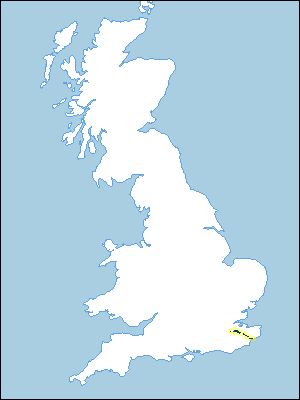
Soil Associations
0571c MALLING
Soil and site characteristics
Well drained non-calcareous fine loamy soils over limestone at variable depths. Some deep well drained coarse loamy soils and similar fine loamy over clayey soils. Some fine loamy soils with slowly permeable subsoils and slight seasonal waterlogging. Occasional shallower calcareous soils over limestone. Landslips and associated irregular terrain locally.
Geology
Cretaceous sand. loam and limestone
Cropping and Land Use
Cereals, potatoes, field vegetables and some short term grassland; fruit in Mid-Kent.
Component soil series
| Subgroup | Series name | Percentage | WRB 2006 link |
|---|---|---|---|
| 5.71 | MALLING | 35% | Endoleptic Luvisols |
| 5.71 | FYFIELD | 15% | Chromic Luvisols |
| 5.72 | BURSLEDON | 15% | Endostagnic Luvisols |
| 5.11 | ABERFORD | 15% | Calcaric Endoleptic Cambisols |
| 5.81 | MARLOW | 10% | Profundic Chromic Luvisols |
Covers 191 km2 in England and Wales
Soilscapes Classification
| 7 |
Freely draining slightly acid but base-rich soils |
0571c MALLING
Detailed Description
This association occurs only in Kent, on Lower Greensand sand, loam and limestone between the coast at Hythe and the river Bourne near Plaxtol. The land was mapped as the Barming-Malling association in their survey of Kent. It occurs on the south facing Hythe Beds escarpment and its extensive dipslope, and a low-lying narrow belt of Sandgate Beds at the foot of the dipslope. Springs emerge where Sandgate Beds pass beneath Folkestone Beds to the north and feed tributary streams to the Stour, Medway and Len. The ridge is capped by Angular Chert Drift, which is probably derived by weathering of Sandgate Beds. The dipslope is largely covered by thin Head derived from the Angular Chert Drift and aeolian silty drift.
Near Ashford, where the Stour breaches the Hythe Beds escarpment, the land is relatively low (60 m O.D.) but it rises towards the coast at Lympne (105 m O.D.), and north¬westwards towards Plaxtol (135 m O.D.). There are landslips on the scarp near Lympne and Boughton Malherbe and cambering is common along valley slopes of the Medway and its tributaries near Maidstone, both adding to the diversity of the soil pattern. The land around Ashford has been mapped in detail and at East Malling, but the soil classification used then has been revised and many of the series renamed.
Mailing soils are fine loamy typical argillic brown earths over sandy limestone, locally known as ragstone, at varying depths below 80 cm, usually with a thin clayey pug layer at the junction. The limestone is interbedded with soft calcareous sandy loam locally called hassock. Shallower typical brown calcareous earths of similar texture over limestone at moderate depth conform to the Aberford series, formerly called Mersham series, and occur on the escarpment and at the heads of shallow dry valleys. Coarse loamy Fyfield soils, the Barming series, typical argillic brown earths, are widespread, occurring on the sandier Hythe Beds intermingled with Malling soils. Deep variably flinty fine loamy Ludford soils occur in drift in hollows and on footslopes. Slightly mottled fine loamy Bursledon soils, many with greenish glauconitic subsoils, are stagnogleyic argillic brown earths. They are common on gently undulating ground on loamy Sandgate Beds, together with similar coarse loamy Ellingham soils. Fine loamy over clayey, reddish-coloured Marlow soils on Angular Chert Drift (formerly called Willington series) are classed as typical paleo-argillic brown earths. They are sporadic on the crest of the escarpment, and many Mailing soils downslope incorporate brightly-coloured cherty material derived from this source. Valley bottoms have occasional silty Hamble soils, loamy soils on river terraces, and strips of mainly clayey or loamy alluvium.
Soil Water Regime
All the soils except Bursledon series are permeable and well drained (Wetness Class I). They readily absorb winter rains and there are few surface streams on the Hythe Beds though some cross the Sandgate Beds outcrop. Compact, finer-textured subsoils in Bursledon series are moderately permeable causing some waterlogging in winter (Wetness Class II) even after field drainage.
Malling, Fyfield and Bursledon soils have moderate reserves of available water and are slightly droughty for cereal crops, moderately droughty for potatoes and moderately or very droughty for grass. Crops are more likely to be affected by drought in the relatively dry Maidstone district, particularly on shallow Aberford soils where there is a restriction to rooting. Irrigation is needed to obtain good yields of potato and grass crops.
Cropping and Land Use
With the exception of Bursledon series, all soils in the association are easy to work and in an average year can be safely cultivated over long periods in autumn and spring. There are fewer opportunities for tillage of Bursledon soils, particularly during wet springs. Droughtiness limits potential yield of grass, particularly on Aberford soils, but the land is rarely poached. Arable crops, chiefly cereals, with potatoes, some field vegetables and ley grassland, are widespread. Fruit is important around Maidstone where apples, pears, soft fruit, and hops are grown. Apart from the Aberford series, most soils are inherently acid but have been limed to maintain an adequate pH. Phosphorus in Fyfield and Malling soils is often above average, but potassium and magnesium status is low. Small amounts of glauconite in some of the soils serve as a slow-acting source of potassium. There is risk of iron deficiency in Aberford soils.
Commons or woodland with semi-natural vegetation are rare but at Hothfield Common there is wet heathland and associated acid peat bog where springs emerge at the junction of Sandgate Beds with overlying Folkestone Beds.
0571c MALLING
Distribution Map
 |
Note that the yellow shading represents a buffer to highlight the location of very small areas of the association.
Keys to component soil series
South Eastern Region
 |
All information Copyright, Cranfield University © 2024
Citation: To use information from this web resource in your work, please cite this as follows:
Cranfield University 2024. The Soils Guide. Available: www.landis.org.uk. Cranfield University, UK. Last accessed 27/04/2024
